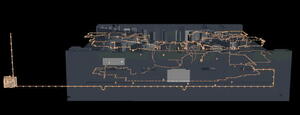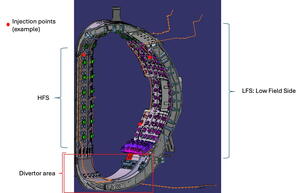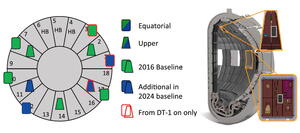Boronization system takes shape as ITER prepares for a tungsten wall
With the help of the fusion community, design modifications are underway to get boron in and out of the machine.
When the ITER Organization made the key decision in 2023 to change the armour tiles of the plasma chamber from beryllium to tungsten, it meant adding a new wall conditioning system to buffer the plasma from the associated increase in impurities. Called boronization, the system will apply a thin layer (~10-100 nanometers) of boron over all plasma-facing surfaces to capture, or “getter,” oxygen that could otherwise increase radiative losses of the plasma, particularly during the sensitive discharge-initiation phase.
ITER engineers and scientists are now working on the diverse aspects of the project—including designing a gas injection system to deliver the carrier gas to different points in the vessel—and plans for the system are advancing quickly, with initial modelling and preliminary design reviews near completion and a long-term strategy defined.
“It’s been a good challenge to integrate boronization into the existing wall conditioning system,” says Tom Keenan, the ITER wall conditioning engineer who is the technical responsible officer for the system. “We’re working with a proven technology, but it’s never been done on this scale or in a tritiated environment, so it’s interesting territory.”
Diborane for boron
When the design for the new wall conditioning system began, one of the first decisions the team made was to use diborane, a compound of hydrogen and boron, for the boronization process. There will be a 5% concentration of diborane in a carrier gas, with helium being the preferred option. Because diborane is both toxic and explosive, a highly secure storage site called a “gas cabin” must be built outside of the Diagnostics Building.
Another requirement is a gas injection system that will bring the diborane into the tokamak. The preliminary design calls for more than one kilometre of injection lines inside the Tokamak Building, another 400 metres of lines in the vessel, and 21 gas injection points to be integrated into the vacuum vessel. An optimized distribution of in-vessel gas supply locations has been achieved that is consistent with the performance benefits identified via the boronization modelling activities and respects the constraints of the existing available vacuum vessel gas feedthroughs. Gabor Kiss, a fuelling process integration engineer at ITER who is working on the integration study, says these adaptations are not expected to impact plant installation sequences.
A bigger role for the glow discharge system
Once injected into the machine, diborane decomposes and deposits on the plasma-facing walls via a glow-discharge-assisted layer deposition method. In glow discharge, an electrical current between the wall (cathode) and "glow anodes" creates a cold plasma, like a neon light, that accelerates ions against the wall. This process causes boron to bond chemically onto the material surface and form a thin film.
ITER already plans to use glow discharge cleaning for wall conditioning during maintenance periods, but adapting it for more frequent use and for boronization raises two main challenges. The first issue is whether ITER’s anode design—which delivers about ten times more energy than those in current tokamaks—is compatible with frequent boronization cycles; upcoming tests at the EAST tokamak in China aim to answer this. The second question involves determining the optimal placement of anodes to ensure even boron coverage on ITER’s plasma-facing surfaces. Through modelling and collaborative testing with the ASDEX Upgrade (Germany) and WEST (France) tokamaks, the team decided to add four additional anodes to the vacuum vessel to obtain the most effective boron distribution.
“This has been a major joint effort with experts from the International Tokamak Physics Activity,” says Tom Wauters, who specializes in plasma-wall interactions at ITER. “We’ve had very good support from the international science and engineering community that has helped us move forward with ITER’s boronization system.”
Determining how often boronization should be performed in ITER hinges on two factors—how much oxygen the boron layer can absorb and how quickly the plasma erodes these layers. Recent studies suggest that a single boron application could be effective for anywhere between 2.5 and 12.5 weeks of campaign time, leading to a planned maximum boronization interval of every two weeks. Upcoming dedicated tests on operational tokamaks will also accurately measure how much oxygen can be captured by the boronized surfaces. This information will guide the ideal frequency for boronization and clarify how much oxygen—such as that introduced by a minor atmospheric leak—the vessel can tolerate.
Diborane usage
In a glow discharge boronization procedure, a low percentage of diborane will remain non-decomposed. The diborane that is pumped out of the tokamak must be safely neutralized due to its high toxicity. Two destruction methods are currently being evaluated: one involves heating the diborane to 700 °C for thermal breakdown, while the other uses a proprietary chemical trap, used in the semiconductor industry, to absorb and neutralize the gas.
“We are very confident in both systems,” says Peter Speller, the process engineer overseeing diborane treatment. “Thermal destruction has already worked at WEST and DIII-D (USA) tokamaks, while the chemical trapping system has been successful at ASDEX Upgrade, so we just need to determine which is best suited to ITER.”
Whatever method is chosen, space is being made in the Tritium Building for the diborane removal system, which will treat the exhaust gases from the tokamak during boronization.
The installation of the boronization system is expected to begin in 2028.




